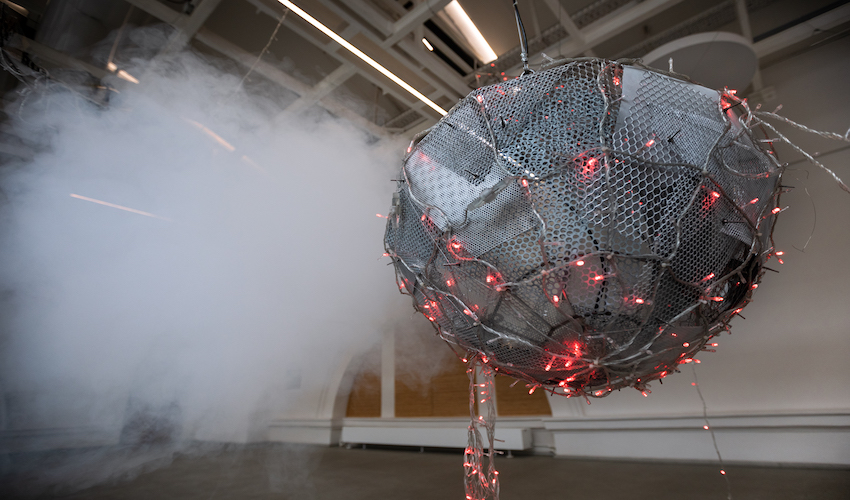Words by Sofya Akimova

Lee Bul’s first exhibition in Russia, Utopia Saved, opened on November 13 in St Petersburg’s Manege Exhibition Hall. For three months, Manege is a place where the utopian ideas from the early 20th century meet the realities of the dystopian present.
The exhibition’s focus is on creating a dialogue between Lee Bul and the works of the Russian avant-garde that inspired her. This is the first time that Lee Bul’s works are being shown together with these works, which have served as the artist’s main source of inspiration since the start of this century.
At Utopia Saved, viewers enter into this dialogue immediately: the gigantic mirrored Zeppelin at the entrance to the exhibition seems to have flown right out of Vasily Kuptsov’s canvas Dirigible. This piece also hearkens back to the catastrophe of the German dirigible Hindenburg in 1937. The crash of the Hindenburg marked the end of the dirigible era and also symbolised a farewell to utopia.
The 1920s gave rise to the conviction that another war was impossible, to dreams of a new world and an equal society, and to the desire to redirect energies from war and destruction to building and creation. As we know, these dreams collided head-on with the horrors of the Second World War and totalitarianism. With this irony in mind, Lee Bul looks at the utopia of modernism from the heights of the 21st century; it is the theme that ties the exhibition together.
It is not expressed directly, but it is nonetheless palpable. The huge installations do not attempt to convince you of anything or make you tremble before the mysterious future. They are simply models for visitors to photograph. Lee Bul has successfully conveyed the modern detachment from utopias, their fragility, and their suitability for museum display.
In the words of the designer of the exhibition’s Russian section, Olesya Turkina, in today’s “futureless” world, one must look backwards to ponder utopia. By calling upon art from the previous century, Lee Bul generates her own worlds, which become a reality in these immersive installations.
While certainly a reference to Thomas Campanella’s book, Lee Bul’s installation Civitas Solis II was at the same time inspired by the artist’s flight over Tokyo at night after the Fukushima disaster. This work shows the contradictions between the modernist ambitions of building an ideal society, which many of the Russian avant-gardes saw as a huge, shining megalopolis, and their sinister reality. The only thing Lee takes from Campanella is the idea of a city of rings and enclosed spaces. The centre of Lee Bul’s city, however, is empty.

Yet another aspect of modernism examined by the artist is the idea of a transparent society. Some of the pieces at Utopia Saved make reference to the work of German architect Bruno Taut. Taut’s most important building, the Glass Pavilion, rejects construction from brick, designating glass as the new symbol of transparency and a new vision for the functioning of society. Lee Bul also uses glass to make her architectural installations, but they are neither transparent nor futuristic. In the modern world, people need secret places that are not accessible without some effort.
Openness and transparency can easily be used to track and surveil people. Lee Bul uses mirrors in her work to distort reality and not to reflect it. The exhibition space turns into a maze that endlessly disorients and disturbs the viewer’s perception of space. We do not even recognise our own reflections in the fragments of mirrors used in one of the pieces. This is how Lee demonstrates the conflict between utopian ideas about social trust with the realities of a modern world under totalitarian control.
Via Negativa II (2014) is another of the exhibition’s mazes. Despite the fact that there is a direct path through the installation, viewers attempting to pass through it risk getting lost. We see our own innumerable, fragmented reflections created by layers of mirrored walls laid on top of one another. The mirrors create infinite illusions. The non-existent spaces take away viewers’ stability and frighten them with images of themselves that do not fit their entrenched ideas.
A dual-language catalogue has been prepared to accompany the exhibition, with articles by experts from around the globe, written especially for the publication and exploring various aspects of Lee Bul’s work. The catalogue is a manifestation on paper of the idea behind the exhibition project: its pages, made from several types of paper, and the fabric on the cover, take the reader back to the theme of borders and the different spaces that can be felt by viewers at the exhibition.
At Utopia Saved, irony and sarcasm are intermixed with trepidation and an understanding of the deep-seated problems of modern society. Full of shininess, reflections, and neon, the space at Manege detaches visitors from reality and encourages them to contemplate their dreams and aspirations.
The works exhibited arouse in viewers’ consciousness a recollection of childhood fascinations with worlds from science fiction while at the same time examining the distant past and acting as messengers from an uncertain, cosmic future.






